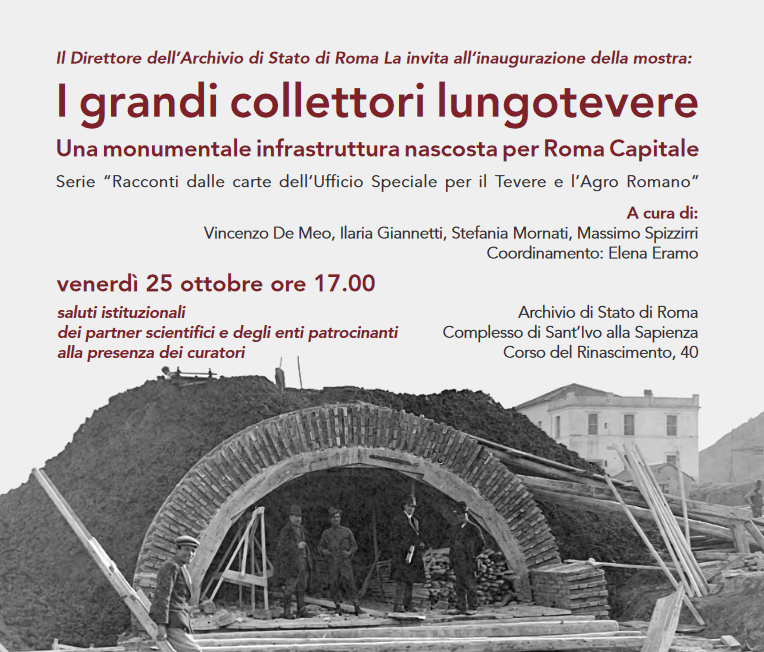An exhibition event to narrate in a documentary way a historical infrastructure of the city. The photographic exhibition is dedicated to this: “The great collectors along the Tiber. A monumental hidden infrastructure for Rome Capital” inaugurated today in the headquarters of the State Archives of Rome, Complex of Sant’Ivo alla Sapienza and scheduled until November 29th. The exhibition is part of the series of exhibition events ‘Stories from the papers of the Special Office for the Tiber and the Agro Romano’ (https://archiviodistatoroma.cultura.gov.it/tag/uffico-speciale-del-genio-civile -per-il-tevere-e-lagro-romano/), curated by the State Archives of Rome in collaboration with the University of Rome Tor Vergata, also being able to count on the scientific partnership of Acea Ato2 and the Capitoline Superintendency for cultural heritage.
With the patronage of Tevere Day – collateral event of the 2024 edition and Aipai – Italian Associations for Industrial Archaeological Heritage. The event is curated by Vincenzo De Meo (State Archives of Rome), Ilaria Giannetti and Stefania Mornati (Dicii, University of Rome Tor Vergata), Massimo Spizzirri (Acea Ato2), with the coordination of Elena Eramo (DICII , University of Rome Tor Vergata). In the years in which Rome becomes the new capital of the Kingdom, the solution to the devastation caused by the continuous floods that have afflicted the most depressed areas for centuries can no longer be postponed.
In December 1870, an extraordinary flood flooded the lower part of the city, reaching a height of 17.22 meters measured at 0 on the Ripetta hydrometer. On 1 January 1871 the Italian Government entrusted a commission of hydraulic engineers with the task of “studying and proposing the means of rendering the floods of the Tiber harmless to the city of Rome”. The Commission is chaired by the engineer Carlo Possenti, then senator and vice-president of the Superior Council of Public Works, and made up of eleven technicians, including Raffaele Canevari.
On 7 December 1871 the Commission proposed a project which, later known as the “Canevari project”, was adopted as the basis for the compilation of the definitive project for the arrangement of the Tiber in Rome, with the aim of creating a regular riverbed in the urban stretch of the river 100 meters wide, delimited by monumental, almost vertical walls. The walls, which are impervious to floods, have large landing docks at the foot and, at the top, new roads along the Tiber whose route coincides with that of the tunnels of the city sewer collectors. In the project, the collectors are considered an integral part of the city’s hydraulic defense, as the lack of maintenance of the ancient sewer system – which dates back to the 6th century. BC, developed in the imperial age as a masterpiece of Roman hydraulic engineering, then enhanced with the urban development of the Renaissance city – contributed to worsening the harmful effects of floods.
Before the start of construction sites, the design of the Canevari embankment was reworked by the technicians of the Special Office for the arrangement of the Tiber, making the collector tunnels independent of the structure of the bank walls. The project of the large collectors thus takes on the characteristics of an autonomous building story that develops in parallel with the construction of the walls: its reconstruction initiated through the reading of the papers scattered in the historical archives, returns the chronicle of a monumental construction site which, spread over the territory, accompanies the construction of contemporary Rome, from the end of the nineteenth century to the twenties of the twentieth century, providing interesting traces of the contamination between the history of engineering and that of the city.
Today the low collectors constitute a fundamental infrastructure of the current sewerage structure of the city of Rome and a monumental work of hydraulic engineering, yet to be rediscovered. In this sense, the studies presented in this exhibition contribute to the knowledge, protection and valorization of this monumental infrastructure. The exhibition represents the fifth exhibition event of the same series, launched in 2020, as part of scientific collaboration agreements between the Department of Civil Engineering and Computer Science (Dicii) of the University of Rome Tor Vergata and the State Archives of Rome for the valorisation of the archival fund of the Civil Engineering of Rome, a documentary collection which is also fundamental for the processes of protection and safeguarding of the historical built heritage of the city of Rome.
